The post Private: Congressional Briefing: The Second Chance Act at 15 Recap appeared first on CSG Justice Center.
Southern Legislative Conference Networking Leads to New Bills
A bill created in West Virginia that would create a work apprenticeship program for 11th and 12th graders stemmed from conversations and networking held at The Southern Legislative Conference.
Bill sponsor Del. Gary Howell, R-Mineral, said he got the idea by hearing about a similar one while attending the Council of State Governments Southern Legislative Conference last summer in Charleston, South Carolina.
“I was learning about this program — I think it was Mississippi, where they were starting apprenticeship programs the last two years of high school, and that there was some federal money available to do this,” Howell said. “So I thought, this is a really good program.”
Delegate Gary Howell currently sits on CSG South’s Executive Committee, Agriculture and Rural Development Committee, and Economic Development, Transportation, and Cultural Affairs Committee.
Read more here:
‘Youth apprenticeship program’ bill raises child labor concerns for advocates | News From The States
The post Southern Legislative Conference Networking Leads to New Bills appeared first on CSG South.
Japan Hosts Delegation, Promotes Education, Engagement with the World as Keys to its Future
By Sean Slone, Senior Policy Analyst
CSG Senior Policy Analyst Sean Slone traveled to Japan in February as a delegate to this year’s Local Government Exchange and Cooperation Seminar hosted by the Council of Local Authorities for International Relations (CLAIR).
Each year, CLAIR invites a group of senior state and local government officials and staff from the organizations that serve them to experience Japan firsthand and engage in enlightening information exchanges and networking. The Japan Local Government Centre, CLAIR’s U.S. office in New York City, is a longtime partner of CSG and other state and local government organizations. Slone was chosen by CSG leadership to participate based on his long tenure at CSG.
This year’s delegation included a mayor from Washington, a state senator from Hawaii and representatives of the International City/County Management Association, National Association of Counties, National Conference of State Legislatures, Sister Cities International, and the Association of Municipal Managers, Clerks and Treasurers of Ontario. The group spent time in Tokyo learning about the local government system before riding the bullet train to Okayama Prefecture for a regional study tour in the southern part of Honshu Island on the Seto Inland Sea.
The United States has a lot riding on the success of Japan. For one thing, the country is a major market for U.S. goods and services, including agricultural products, commercial aircraft and pharmaceuticals.
Moreover, in 2022, Japanese automakers manufactured about 2.82 million vehicles at production facilities in the United States, supporting more than 2.3 million U.S. jobs. Those automobile manufacturers play an essential role in the U.S. economy having invested more than $60 billion in manufacturing facilities over the past 40 years.
Photo: CSG Senior Policy Analyst Sean Slone (second from right) poses for a photo alongside his CLAIR Fellowship Exchange Program attendees at the Korakuen Garden in Okayama on Feb. 15. Photo credit: Natalie O’Donnell Wood, National Conference of State Legislatures.
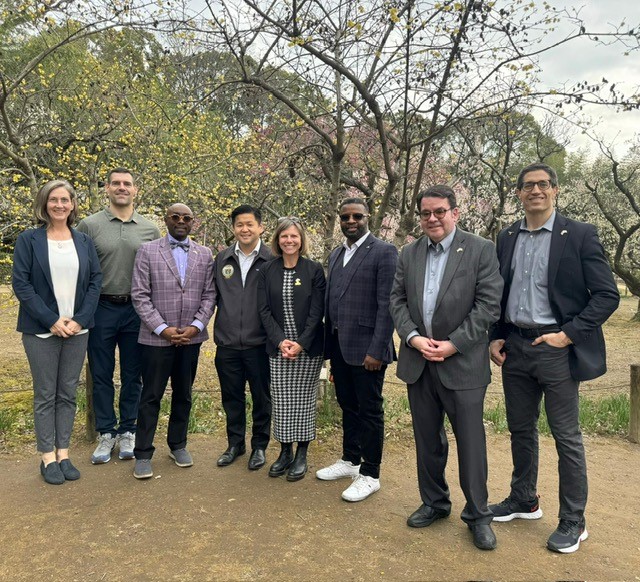
Located near the CSG national headquarters in Lexington, Kentucky, is the community Georgetown, which has benefited considerably from the presence of one of those manufacturers: Toyota Motor Manufacturing. Toyota set up shop in 1986 and now employs more than 9,300 individuals. By one estimate from a few years ago, if indirect jobs and spin-off companies are factored in, the number of jobs supported statewide is closer to 30,000.
State policymakers around the country recognize that maintaining the economic impact of a company like Toyota requires building and maintaining an educated workforce. But in recent years, that is where the United States has struggled, for several reasons. It’s estimated that the U.S. has lost as many as 1.4 million workers from the labor force since the start of the pandemic in February 2020. Meanwhile, the birth rate in the U.S. has decreased since the Great Recession, declining almost 23% between 2007 and 2022. Whereas in 1950, the average American woman gave birth to three children, today that number is around 1.6, significantly below the replacement rate of 2.1 children needed to sustain a stable population.

Photo credit: Commissioner Larry Johnson, DeKalb County, GA

Photo credit: Sean Slone

Photo credit: Sean Slone
While we may not talk much about such declines in the United States, Japanese government officials are very concerned about how a declining population and birth rate on the island nation may impact their future. It was a concern expressed by many of the officials the CLAIR delegation met with in February. However, that concern may ring slightly hollow as you’re wandering the busy streets of Tokyo’s Shinjuku neighborhood on a weekend night, making your way through a busy train station to catch the shinkansen — Japan’s smooth-running bullet train — or jostling with hundreds of other tourists for the best view at Tokyo Skytree, the 2,000-foot-high broadcasting and observation tower that affords a commanding sense of the scope of the world’s most populous city.
Still, government officials predict that most Japanese prefectures will see significant declines in population between now and 2050. Eleven prefectures will each see their population shrink by more than 30%, according to the National Institute of Population and Social Security Research. Moreover, the Health, Labor and Welfare Ministry reported that the number of babies born in 2021 fell by nearly 30,000 from the previous year. At the same time, the number of people age 65 or older in Japan reached a record high of 36.27 million in 2022.
The reason for the concern in Japan is that the regions expected to experience the biggest population declines are likely to face declining tax revenues and economic contraction, making it difficult to maintain infrastructure and local government services. And while Tokyo is expected to remain hugely popular both with Japanese and transplants from elsewhere — its population is expected to increase 2.5% over the same period — many believe the concentration of people in the city is a matter of some urgency.
Shunsuke Kimura, a professor in the Graduate School of Governance Studies at Tokyo’s Meiji University, told CLAIR seminar delegates the nation’s long-term vision for taking action against a shrinking society includes four objectives:
- Generating stable employment in regional areas.
- Creating a new inflow of people into regional areas.
- Fulfilling the hopes of the young generation for marriage, childbirth and parenthood.
- Creating regional areas suited to the times with safe and secure living and cooperation with other regions of the country.
One factor that many believe could help lift Japan’s outlying regions — and one that U.S. communities might want to take some cues from — is a focus on education that emphasizes both civic engagement at home and study abroad programs that allow students to experience other parts of the world.
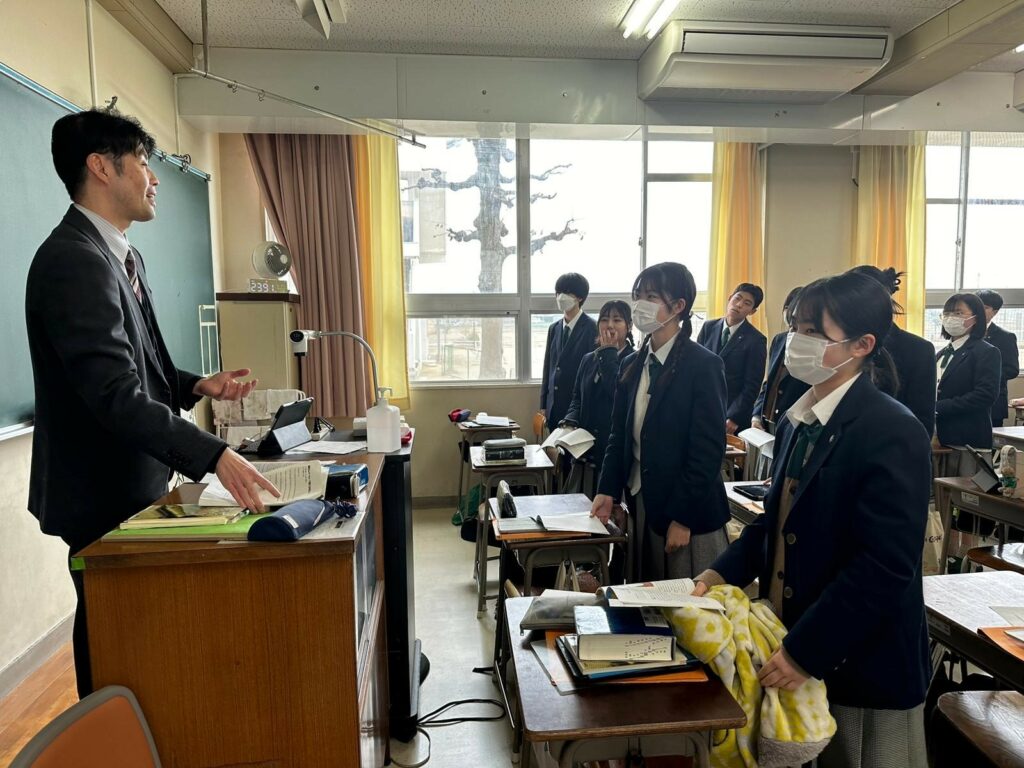
Photo credit: Commissioner Larry Johnson, DeKalb County, GA
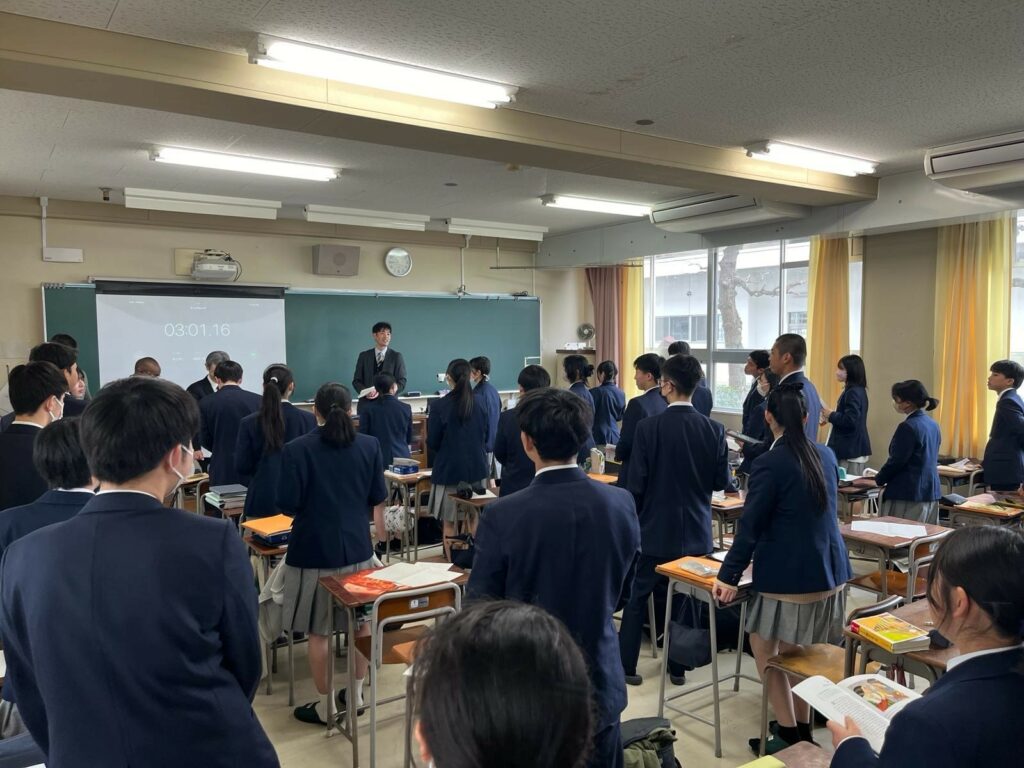
“Romeo and Juliet” at Joto High School.
Photo credit: Mayor Mary Lou Pauly, Issaquah, WA
During a visit to Okayama Prefecture, CLAIR delegates had the opportunity to visit Joto High School and hear about the school’s system for “raising global leaders.” School officials detailed characteristics they aim for in their students, including both support for the local community and a global mindset. They said they seek to nurture creative and critical thinking as well as an ability to use advanced English. The school emphasizes three initiatives, including studying community issues, deepening cultural exchange, and fostering independence and autonomy. As part of a three-year program, students learn cross-curriculum research skills, visit local companies to learn about global issues, conduct empirical research with an emphasis on regional fieldwork, and in year three, do personalized, in-depth research and thesis writing in both English and Japanese, while focusing on four courses: humanities and social sciences, international studies, science and math, and music.
In one classroom at Joto, delegates observed students studying and discussing a simplified version of Shakespeare’s “Romeo and Juliet” in English (it was the week of Valentine’s Day). In another classroom, students were invited up front to play back elaborate musical compositions they had composed. Down the hall, others were conducting experiments with beakers and Bunsen burners.
Perhaps most impressive was a presentation from a young girl titled “Visualizing Abstract Japanese Aesthetics.” It was a highly conceptual, multi-disciplinary exploration of complex themes such as the core concept to Japanese aesthetics of “wabi-sabi” — the notion that beauty and enjoyment can be found within the deterioration of worldly things. Or as the young student put it, “beauty in decay.”
Joto students also can experience numerous international exchanges, including long-term or short-term study abroad programs in Australia, Canada and the United States.
Student exchange is also a focus at Okayama Prefectural University, the 30-year-old higher education institution in the city of Soja that was also on the delegation’s travel itinerary. University officials there highlighted global partner universities and international networks across North America, Europe, Asia, Oceania and Africa. The university serves a student body of just over 1,700 studying in areas like health and welfare science, computer engineering and design. One student detailed her year of study in Toronto at the University of Guelph, where she created a club for fellow students on making vegetarian Japanese food.
The international focus highlighted across Okayama seemed to reflect the life experience of Ryūta Ibaragi, the prefecture’s dynamic and long-serving governor, who in 1995 received a Master of Business Administration from the Stanford University Graduate School of Business. The governor, whom delegates got the chance to meet and exchange gifts with, has established as one of his priority initiatives reclaiming Okayama’s status as the “Education Prefecture.”
Photo: Ryūta Ibaragi, governor of Okayama Prefecture, speaks to members of the CLAIR delegation at the Okayama Prefectural Office on Feb. 14. Photo credit: Sean Slone.
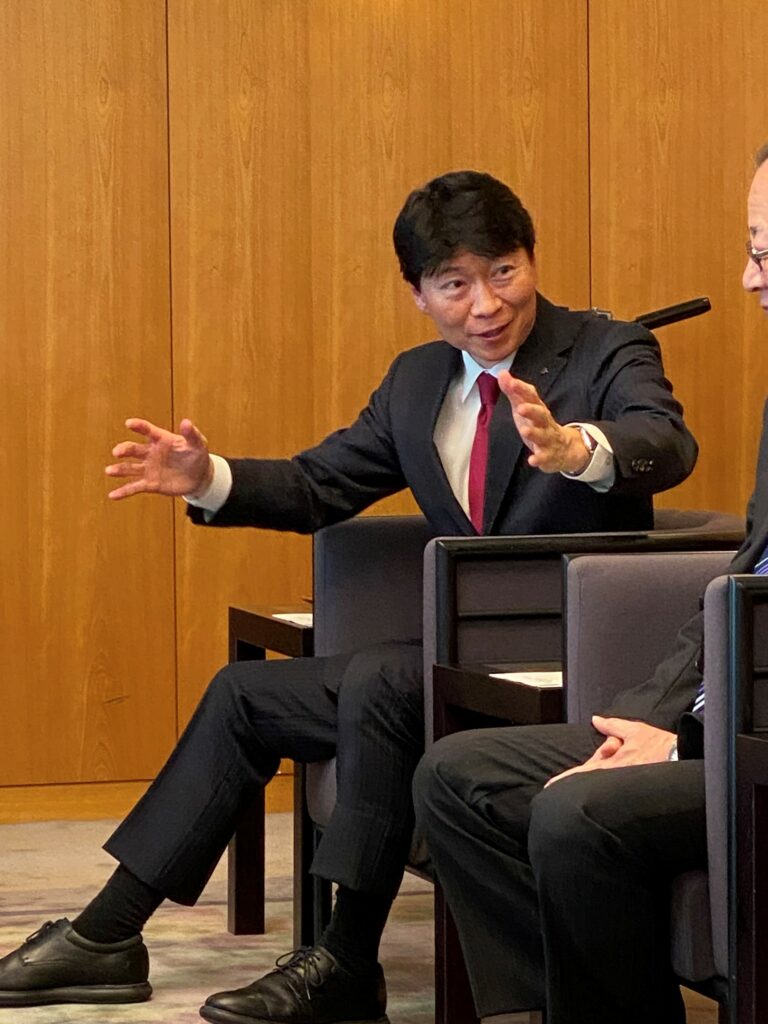
While education may be a key to the future of many places in Japan as the country tries to reverse course on its shrinking society, another concern has emerged more recently in the island nation: a shrinking economy. Last year, Japan lost its spot as the world’s third-largest economy, contracting in the fourth quarter of 2023 and slipping into recession as it fell behind Germany.
But there aren’t many countries in the world where recession would look quite like this. There is commerce everywhere in Japan. From the high-end retailers at every multi-story department store in Tokyo to the businesses clustered around Japan’s train stations to the ubiquitous convenience stores where you can get a surprisingly decent late-night snack and cook and eat it on-site. Wandering the well-stocked aisles of the enormous Don Quijote discount store in Shinjuku, it begs the question: Who is buying all this stuff? Isn’t there a recession going on?
One place providing respite from the non-stop commerce is the peaceful Okayama Korakuen Garden, a 300-year-old Japanese garden that is considered one of the nation’s three great gardens. Unlike one of the gardens of Europe, where the goal is to keep things looking much as they did in the time of long-dead monarchs, Korakuen will not be the same 50 or 100 years from now, we were told. It is designed in the “scenic promenade” style, which presents the visitor with a new vista from every path or tea house on the property. And as an Italian guide told the delegation, the garden is a “moment in time.” It is a memento mori — a reminder of impermanence and the inevitability of death, a reminder of the beauty in decay. Like the cherry blossom — Japan’s enduring symbol of beauty and mortality — it is ephemeral, here one day and gone the next.
As the group prepared to leave Okayama Prefecture and return to Tokyo, delegates were invited to give their impressions of the trip. One of our fellow travelers suggested he needed a couple more days to experience Japan. I told the CLAIR and prefectural staff I needed a couple more lifetimes. But I get the feeling that if I were to return to Japan every year and immerse myself in the country, it would be difficult to ever truly know Japan. Like the garden, the country is a moment in time. A remarkable, unknowable place where past and present collide, and where its residents are trying to shape a bright future despite ominous headwinds.
Relaunch of The National Center for Interstate Compacts Database
The Council of State Governments National Center for Interstate Compacts has relaunched its national database of interstate compacts. The database tracks more than 2,000 interstate compact enactments from nearly 300 different compacts which date back to the founding of the United States. In addition to compact enactment data, the database provides pertinent information regarding interstate compacts and commissions, including the compact model language and the name and website of the commission associated with the compact.
The National Center for Interstate Compacts is one of the most longstanding programs at CSG, providing technical assistance in the development of numerous interstate compacts. In addition, the National Center for Interstate Compacts seeks to educate CSG membership and the public functions of interstate compacts.
According to CSG Chief Public Policy Officer Shawn Jurgensen, the National Center for Interstate Compacts Database will contribute to the success of CSG in the field of interstate compacts and help promote innovative forms of interstate cooperation.
“Some of the greatest policy achievements in the history of the United States have been a result of interstate compacts,” said Jurgensen. “The driver’s license, metropolitan transportation systems in New York City and Washington, D.C., and numerous interstate projects on the protection of natural resources have all been developed through interstate compacts. By providing policymakers and our members with the most comprehensive database on interstate compacts available, we greatly enhance our ability to serve state leaders as they develop innovative interstate solutions. The Council of State Governments is the national leader in interstate compacts and this database will ensure we remain state government’s go-to source in this essential policy area.”
This database will be the most comprehensive collection of interstate compact data available and will allow the public to research interstate compact enactments which span 21 different policy areas and include enactments from every state as well as numerous U.S. territories and Canadian provinces.
CSG staff worked alongside Jeff Litwak, general counsel to the bi-state Columbia River Gorge Commission, adjunct professor of law at Lewis and Clark Law School and contributor to the American Bar Association’s casebook on interstate compact law, to gather information for the database.
“There are numerous resources aggregating the practice and law of interstate compacts, but they are not a substitute for CSG’s database,” said Litwak. “The database is my go-to source for compacts, where I can get copies of states’ enactments and compare them, make lists of compacts for legal briefs and send my students to start their research. The database has also been cited in several court decisions, so we know judges are finding it. It is one of the most valuable compact resources for empirical research.”
CSG invites policymakers, researchers and the public to utilize our database for their work and to gain knowledge on interstate compacts and their impact on shaping the landscape of public policy throughout the country. The National Center for Interstate Compacts hopes that the relaunch of the National Center for Interstate Compacts Database will promote new discussions around interstate compacts so we encourage those who visit the database to provide feedback on how it can better serve their needs.
Southern States Approaches to Regulating Artificial Intelligence, Autonomous Decision-Making, and Machine Learning
In a brief nine-month period between late 2022 and early 2023, users in the United States conducted nearly 19 billion visits to the most popular generative artificial intelligence (AI) application on the web. These American users – more than 5.5 billion – represented more than 22 percent of these AI applications’ worldwide user base. Despite rising to prominence among the cultural zeitgeist, these tools are still in a state of early integration in business and public sector work, with the United States Census Buraeu’s Business Trends and Outlook Survey reporting that, as of November 28, 2023, less than 4 percent of U.S. businesses say they are using artificial intelligence to produce goods or services. Recognizing the urgent need to study how existing regulations apply and what new guardrails are needed for AI, state leaders are taking steps to understand this complex topic as its usage increasingly gains widespread commercial appeal.
In response to the proliferation of AI, state lawmakers across the U.S. introduced more than 780 pieces of legislation concerning aspects of artificial intelligence. From the first proposal filed in 2003 to the more than 200 measures proposed in 2023 alone, this issue has been on members’ minds for more than a decade.
Click Here to Download the Full Issue Alert
The post Southern States Approaches to Regulating Artificial Intelligence, Autonomous Decision-Making, and Machine Learning appeared first on CSG South.
A Tough Pill To Swallow: How States Are Facilitating School Responses to Youth Opioid Overdoses
From the small towns of Appalachia and the rural Deep South to the college towns in the heartland, the heights of the Ozarks and Smokey Mountains, the vacation destinations of the Gulf and Atlantic Coasts, and beyond, abuse and misuse of illicit or prescribed opioids is an epidemic without boundaries. Indeed, every state in the South has suffered dearly from this crisis. Nearly one in four (or 24.9 percent) individuals aged 12 or older reported illicit drug use or abuse in the past year. According to the 2022 National Survey on Drug Use and Health by the Substance Abuse and Mental Health Services Administration (SAMHSA) of the United States Department of Health and Human Services, more than 3.5 million youth between the ages of 12 and 17 misused prescription or illicit drugs in the past year – including more than 420,000 who used or misused opiates. Most of these individuals (44.6 percent) reported receiving, stealing, or purchasing opioids from friends or relatives, while another 41.3 percent were prescribed or stolen from a healthcare provider. Others bought from a drug dealer or other unknown individual (8.5 percent) or obtained the drugs some other way (5.6 percent).
This is especially troubling given the seven states that dispense opioids at the highest rate are in the South – Alabama, Arkansas, Kentucky, Louisiana, Mississippi, Oklahoma, and Tennessee – making youth in these states inherently more vulnerable to exposure to these dangerous drugs.
Click Here to Download the Full Regional Resource
The post A Tough Pill To Swallow: How States Are Facilitating School Responses to Youth Opioid Overdoses appeared first on CSG South.
2024 MLC Chair’s Initiative on Workforce | Governors tout successes, new policies to build talent pipelines
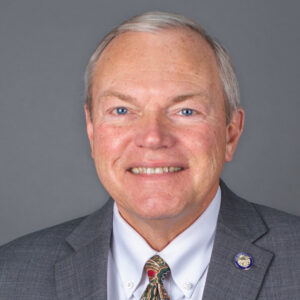 Innovation in workforce policy and development is the focus of the 2024 Midwestern Legislative Chair’s Initiative of Ohio Sen. Bill Reineke (pictured to the right). In support of the initiative, CSG Midwest is producing a series of articles, research briefs and policy sessions for the region’s legislators on this initiative.
Innovation in workforce policy and development is the focus of the 2024 Midwestern Legislative Chair’s Initiative of Ohio Sen. Bill Reineke (pictured to the right). In support of the initiative, CSG Midwest is producing a series of articles, research briefs and policy sessions for the region’s legislators on this initiative.
Below, we explore the State of the State addresses delivered by Midwestern governors in early 2024 and focus on their ideas for building talent pipelines and addressing workforce shortages. We look at four common policy strategies:
- Boost rates of postsecondary attainment
- Expand the reach of apprenticeship programs
- Address the child care needs of families
- Recruit out-of-state workers
Strategy #1: Boost rates of postsecondary attainment
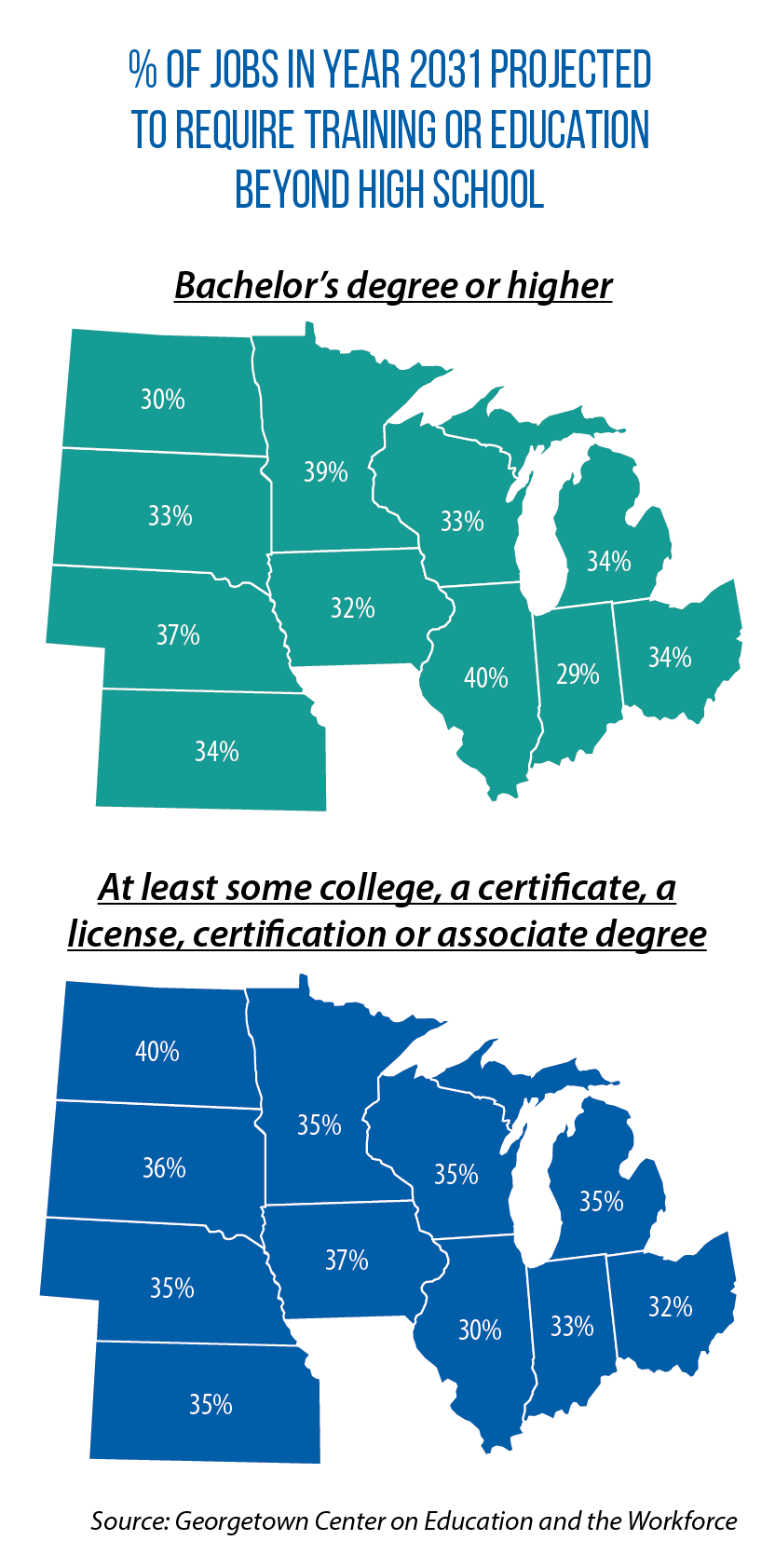 More jobs are requiring some postsecondary education and training beyond high school, a workforce reality noted in several of the governors’ recent speeches and proposals.
More jobs are requiring some postsecondary education and training beyond high school, a workforce reality noted in several of the governors’ recent speeches and proposals.
In Michigan, Gov. Gretchen Whitmer wants to make the first two years of community college tuition-free for every high school graduate. For students, she said, the plan would open new opportunities to pursue better-paying jobs. But Whitmer also noted that the state and its businesses will benefit from a larger pool of postsecondary-trained workers.
“As more supply chains come home and advanced manufacturing businesses expand in Michigan, they will need qualified talent,” she said. The state’s goal is to have 60 percent of working-age adults with a college degree or postsecondary skill certificate by 2030.
Six years ago, Iowa lawmakers set this statewide target: by 2025, 70 percent of the workforce should have education and training beyond high school. To get there, new programs were established and funded under the Future Ready Act (HB 2458 of 2018). For instance, a last-dollar scholarship has been made available to students pursuing degrees or certificates in high-need occupations. In fiscal year 2023, a total of $24 million went to nearly 10,000 Iowans. An associate degree in nursing was the most common occupation being pursued.
In her January 2024 address, Gov. Kim Reynolds reported to legislators that the state had reached its 70 percent goal ahead of schedule.
“Future Ready Iowa was born in this building with an executive order and bipartisan legislation; we set the vision and laid the foundation,” she said. “But elected leaders aren’t the ones who got it done. It was the people of Iowa … who created a new culture, merging the worlds of work and education like never before.”
At the start of Indiana’s 2024 session, Indiana Gov. Eric Holcomb challenged education and policy leaders to find new ways of making college more accessible. Among his ideas: create more degree options. Under SB 8, every public university would need to offer at least one three-year degree program, as well as study the feasibility of offering associate degrees to students.
Strategy #2: Expand reach of state-supported apprenticeship programs
 Another feature of Iowa’s Future Ready initiative has been to invest more in registered apprenticeships — “earn and learn” programs for people to get paid while receiving on-the-job training and skills. Part of Iowa’s strategy has been developing and expanding new apprenticeships in high-demand fields. (The state’s Workforce Development Board identifies the high-demand fields).
Another feature of Iowa’s Future Ready initiative has been to invest more in registered apprenticeships — “earn and learn” programs for people to get paid while receiving on-the-job training and skills. Part of Iowa’s strategy has been developing and expanding new apprenticeships in high-demand fields. (The state’s Workforce Development Board identifies the high-demand fields).
One of Reynolds’ policy goals for 2024 is to expand high school students’ access to apprenticeships or other work-based learning opportunities (internships, job shadowing, etc.) in targeted industries.
In her 2024 State of the State address, South Dakota Gov. Kristi Noem highlighted the impact of recent investments in apprenticeships, including a new three-year, $7.9 million grant program. With that money, apprenticeship sponsors are eligible for up to $15,000 in funding support as well as state technical assistance.
“In just the first two quarters since launching the expanded effort, we’ve more than doubled the amount of new apprenticeships,” Noem said.
Raising awareness about apprenticeships and other worker training programs is the goal of Indiana’s One Stop to Start, a new web resource highlighted by Holcomb during his State of the State address. The “one stop” resource highlights high-growth industries in Indiana and includes a listing of state-supported education and training opportunities. Additionally, individuals can get connected with a career navigator to explore potential options.
In Ohio, Gov. Mike DeWine called for a statutory change requiring every high school student to have a career plan upon graduation from the the state’s K-12 system. “The [current] law fails to require maybe the most important thing — a plan for students to find a career they love and can excel at after graduation,” he said.
He also hailed recent state-level investments in career technical education, including $200 million in grants for new or expanded classrooms and more than $67 million to pay for new equipment in career tech programs.
Strategy #3: Address the child care needs of families
In Kansas, more than half of the families in search of child care cannot find an open slot, Gov. Laura Kelly said to legislators in January. “[It’s] forcing many parents to quit their jobs, and the shortages are worst in our rural areas.”
Her proposed budget includes $56 million for child care. More than half of this money would be used to build up Kansas’ child care infrastructure — grants to build new facilities or expand existing operations. Local and private dollars match the state-level support.
Kelly also proposed one-time funding of $5 million for a public-private partnership in a 26-county region of northwest Kansas. Combined with private dollars and the support of local foundations, the state dollars would create a new endowment, a sustainable source of funding to add child care slots in this region’s mostly rural communities. If successful, the approach could be replicated in other parts of Kansas.
Nebraska Gov. Jim Pillen has proposed building a “micro-center” network of child care programs.
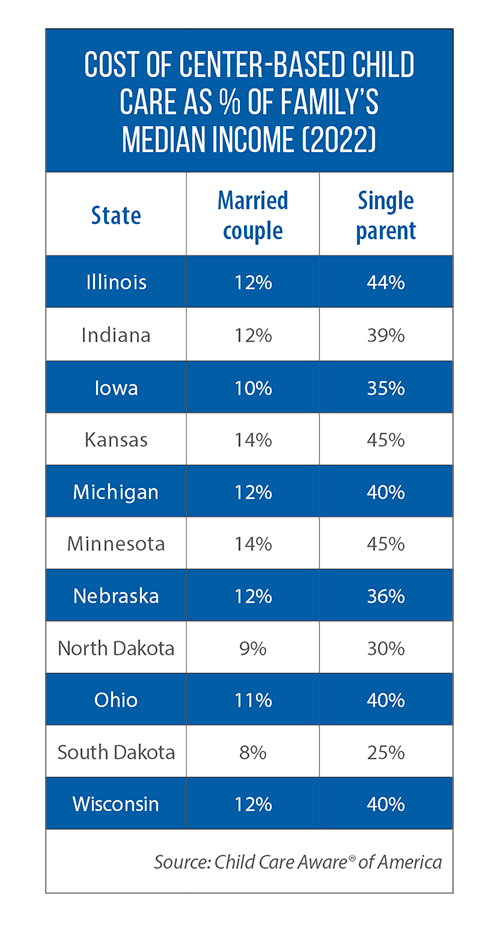 This model aims to remove some of the common infrastructure and operational obstacles faced by smaller-sized, family-based child care providers — for example, a lack of space to expand capacity in their homes or a lack of capital to build a stand-alone center.
This model aims to remove some of the common infrastructure and operational obstacles faced by smaller-sized, family-based child care providers — for example, a lack of space to expand capacity in their homes or a lack of capital to build a stand-alone center.
Here is how it works: Smaller providers get low- or no-cost space to deliver care in a few rooms of an existing facility (a school or business in the community, for example). These smaller providers also then get administrative and technical support from a shared, outside entity.
Nebraska’s LB 1416 would establish a state grant program to pursue the micro-center model.
In Illinois. Gov. J.B. Pritzker told legislators in February that with continuing state investments for an initiative known as “Smart Start,” universal preschool for 3- and 4-year-olds could be achieved by 2027. Last year’s Illinois budget included $300 million in new funding for child care and early-childhood education. With those additional dollars, the state is
- providing grants to schools and nonprofit operators to create more child care slots and for private operators to expand operations;
- investing in programs that raise the wages of workers in this sector and that create new scholarship and apprenticeship programs; and
- expanding the availability of child care assistance for lower-income families.
“Smart Start is having the desired benefit for working parents and their children,” Pritzker said. “Child care utilization rates are higher than ever before.”
Last year, North Dakota legislators took steps to expand child care capacity, and Gov. Doug Burgum hailed that $66 million investment in his 2024 State of the State address. As part of the enacted legislation (HB 1540), more families became eligible for state-funded child care assistance, providers are being paid at higher rates, and employers are getting incentives to cover part of their workers’ child care expenses.
“What’s happening with that investment, now more than 4,800 working families have received help with child care costs just in the first six months of this biennium; more than 300 child care business have benefited from grants and incentives,” Burgum said. “Think of that, close to 5,000. When we talk about trying to solve our issue with 30,000 jobs open, we put a huge dent in it … because we got 5,000 people that maybe came back into the
workforce.”
Wisconsin Gov. Tony Evers told legislators in January that a child care crisis is imminent minus state action; public funding is needed to keep many centers open, he said. Like other Midwestern governors, too, Evers linked the lack of child care availability to a shortage of workers.
“From my vantage point, three things are key to addressing our state’s workforce challenges: First, we must find a long-term solution to our state’s looming child care crisis; second, we must expand paid family leave; and third, we must invest in public education at every level, from early childhood to our technical colleges and universities.”
On that second priority, Evers has proposed a state investment of $240 million to jump-start a program that would ensure 12 weeks of paid family leave for most private-sector employees.
Last year, Minnesota legislators established a state-run insurance program providing workers with up 20 weeks of family and medical leave and also created a first-in-the-Midwest Child Tax Credit.
In his 2024 State of the State address, Minnesota Gov. Tim Walz highlighted a new state biennial budget that includes expanded access to Early Learning Scholarships and Child Care Assistance programs as well as voluntary, publicly funded prekindergarten. Legislators also invested in higher pay for child care workers and higher compensation rates for providers.
“We’ve expanded access to pre-k and affordable child care,” Walz said in his address.
Strategy #4: Recruit new workers to the state
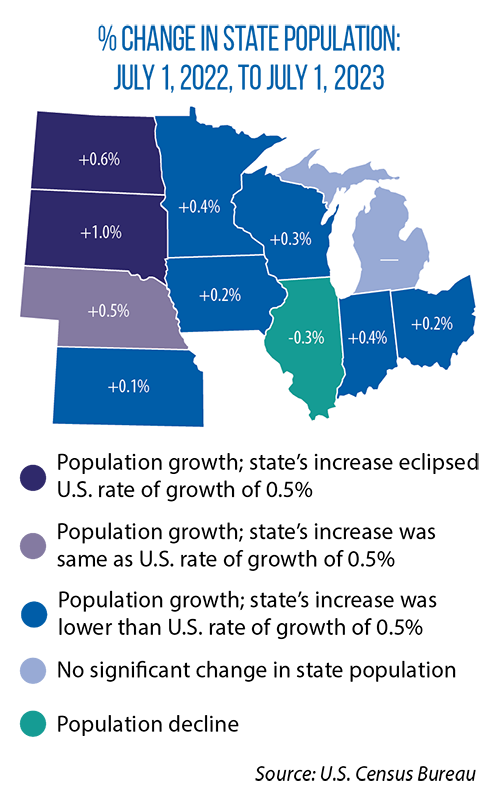 Pillen and Noem said part of their states’ strategies for alleviating workforce shortages should be to attract out-of-state talent.
Pillen and Noem said part of their states’ strategies for alleviating workforce shortages should be to attract out-of-state talent.
Pillen has proposed a new tax credit for employers who cover the relocation expenses of people who move to Nebraska for work (LB 1400). The credit is up to $5,000 per employee. The relocating worker must have an annual wage of between $70,000 and $250,000. That worker also would get a one-time income tax break.
“We must recognize that investing in the twenty-first century workforce is different from what we’ve done before,” Pillen said. “No longer can we focus tax breaks on companies that are takers, not givers, and that do not share our values.
In June 2023, South Dakota launched “Freedom Works Here,” a workforce-recruitment campaign with targeted ads for the state’s highest-demand professions — for example, electricians, plumbers, welders, accountants and nurses. This campaign, combined with recent statutory changes that recognize out-of-state professional licenses, has led to more job applicants and a year-over-year increase of 10,000 people in the labor force, Noem said.
“This is indisputably the most impactful workforce campaign in South Dakota’s history,” she added.
The post 2024 MLC Chair’s Initiative on Workforce | Governors tout successes, new policies to build talent pipelines appeared first on CSG Midwest.



